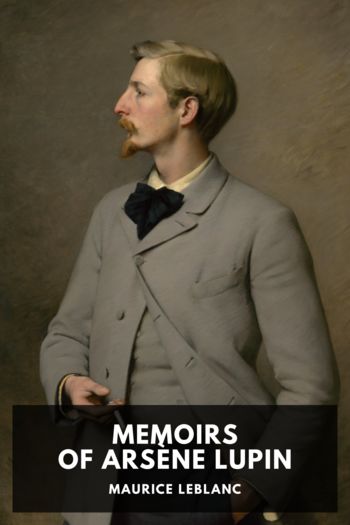The Hollow Needle by Maurice Leblanc (best book clubs .txt) 📕

- Author: Maurice Leblanc
Book online «The Hollow Needle by Maurice Leblanc (best book clubs .txt) 📕». Author Maurice Leblanc
“If you stir a limb, I fire!”
At the same time his two satellites drew their weapons and aimed them at Lupin.
Lupin drew himself up, stifled the rage within him and, coolly, with his hands in his pockets and his breast exposed to the enemy, began once more:
“Shears, for the third time, let that woman be—”
The Englishman sneered:
“I have no right to touch her, I suppose? Come, come, enough of this humbug! Your name isn’t Valméras any more than it’s Lupin: you stole the name just as you stole the name of Charmerace. And the woman whom you pass off as your mother is Victoire, your old accomplice, the one who brought you up—”12
Shears made a mistake. Carried away by his longing for revenge, he glanced across at Raymonde, whom these revelations filled with horror. Lupin took advantage of his imprudence. With a sudden movement, he fired.
“Damnation!” bellowed Shears, whose arm, pierced by a bullet, fell to his side. And, addressing his men, “Shoot, you two! Shoot him down!”
But already Lupin was upon them: and not two seconds had elapsed before the one on the right was sprawling on the ground, with his chest smashed, while the other, with his jaw broken, fell back against the gate.
“Hurry up, Victoire. Tie them down. And now, Mr. Englishman, it’s you and I.”
He ducked with an oath:
“Ah, you scoundrel!”
Shears had picked up his revolver with his left hand and was taking aim at him.
A shot—a cry of distress—Raymonde had flung herself between the two men, facing the Englishman. She staggered back, brought her hand to her neck, drew herself up, spun round on her heels and fell at Lupin’s feet.
“Raymonde!—Raymonde!”
He threw himself upon her, took her in his arms and pressed her to him.
“Dead—” he said.
There was a moment of stupefaction. Shears seemed confounded by his own act. Victoire stammered:
“My poor boy—my poor boy—”
Beautrelet went up to the young woman and stooped to examine her. Lupin repeated:
“Dead—dead—”
He said it in a reflective tone, as though he did not yet understand. But his face became hollow, suddenly transformed, ravaged by grief. And then he was seized with a sort of madness, made senseless gestures, wrung his hands, stamped his feet, like a child that suffers more than it is able to bear.
“You villain!” he cried, suddenly, in an access of hatred.
And, flinging Shears back with a formidable blow, he took him by the throat and dug his twitching fingers into his flesh.
The Englishman gasped, without even struggling.
“My boy—my boy—” said Victoire, in a voice of entreaty.
Beautrelet ran up. But Lupin had already let go and stood sobbing beside his enemy stretched upon the ground.
O pitiful sight! Beautrelet never forgot its tragic horror, he who knew all Lupin’s love for Raymonde and all that the great adventurer had sacrificed of his own being to bring a smile to the face of his well-beloved.
Night began to cover the field of battle with a shroud of darkness. The three Englishmen lay bound and gagged in the tall grass. Distant songs broke the vast silence of the plain. It was the farmhands returning from their work.
Lupin drew himself up. He listened to the monotonous voices. Then he glanced at the happy homestead of the Neuvillette, where he had hoped to live peacefully with Raymonde. Then he looked at her, the poor, loving victim, whom love had killed and who, all white, was sleeping her last, eternal sleep.
The men were coming nearer, however.
Then Lupin bent down, took the dead woman in his powerful arms, lifted the corpse with a single effort and, bent in two, stretched it across his back:
“Let us go, Victoire.”
“Let us go, dear.”
“Goodbye, Beautrelet,” he said.
And, bearing his precious and awful burden followed by his old servant, silent and fierce he turned toward the sea and plunged into the darkness of the night.
EndnotesArsène Lupin, play in three acts and four scenes, by Maurice Leblanc and Francis de Croisset. ↩
Arsène Lupin Versus Holmlock Shears, by Maurice Leblanc. ↩
The Seven of Hearts, by Maurice Leblanc. II; Arsène Lupin in Prison ↩
The Seven of Hearts. IX: Holmlock Shears Arrives Too Late. ↩
The Seven of Hearts. IV: The Mysterious Railway-passenger. ↩
Arsène Lupin Versus Holmlock Shears, by Maurice Leblanc, Chapter V: Kidnapped. ↩
Arsène Lupin, play in four acts, by Maurice Leblanc and Francis de Croisset. ↩
Les Origines d’Étretat. The Abbé Cochet seems to conclude, in the end, that the two letters are the initials of a passerby. The revelations now made prove the fallacy of the theory. ↩
The toise, or fathom, measured 1.949 metres. —Translator’s Note ↩
Magna porta. ↩
The Exploits of Arsène Lupin. By Maurice Leblanc. VI: The Seven of Hearts. ↩
Arsène Lupin, play in four acts, by Maurice Leblanc and Francis de Croisset. ↩
List of IllustrationsA diagram consisting of three lines of text, followed by one line of characters and symbols, followed by one more line of text. The lines of text just have numbers showing; the remaining characters are simply full stops. The line of characters and symbols reads: D, DF under a line, a rectangle, 19 F + 44, a right triangle lying on the hypotenuse with a dot at the left corner, 357, and the same triangle flipped horizontally.
A diagram consisting of four lines of text with just vowels showing; the remaining letters are simply full stops.
A diagram consisting of three lines of text, followed by one line of characters and symbols, followed by one more line of





Comments (0)